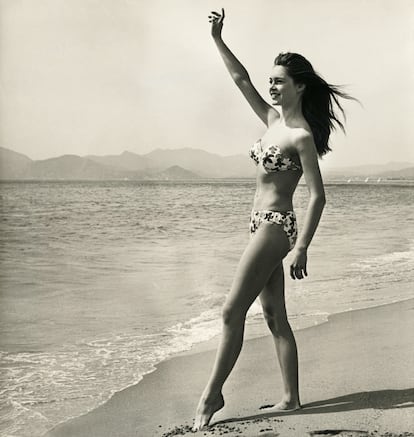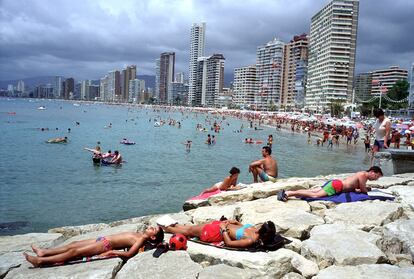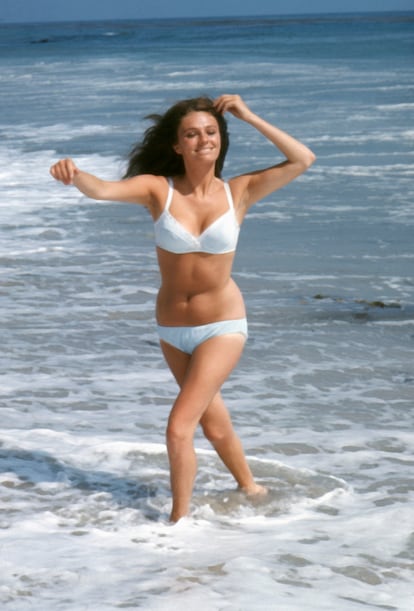How the bikini subverted fascism in 1950s Spain by entering through Benidorm
The Mediterranean resort severed ties with the repressive morality of the Franco regime, which censored the two-piece swimsuit. The city’s mayor defended its use to avoid losing its status as a global tourist destination

When it comes to fashion, women’s closets have always been under scrutiny. Even in the middle of 2023, women’s attire is still questioned at the slightest opportunity. But if we look back at recent fashion history, perhaps no other garment has been as controversial as the bikini. Seventy years ago, Benidorm — then a sleepy fishing village on the Mediterranean coast — played a key role in promoting the use of this swimsuit in a black-and-white era in Spain.
In 1950s Spain, where customs and habits were far removed from those of much of Europe and the United States, there was no trace of the two-piece, bra and panty design that various actresses had begun to wear in the movies. One of the first to wear it was Brigitte Bardot in the 1950s. But its origins go back to the 1940s. “Although in the 1930s we could see two-piece garments in sports closets, it was in the 1940s that the famous bikini appeared. Today almost everyone has worn one, but at the time, [it] revolutionized the world of fashion,” says Amalia Descalzo Lorenzo, professor of Culture and Fashion at Isem Fashion Business School at the University of Navarra. Its creation is attributed to French engineer Louis Réard, who in 1946 presented his design just a few days after an atomic bomb was tested on Bikini Atoll in the Marshall Islands. “In Paris, Réard presented a daring two-piece swimsuit that he named after Bikini Atoll. [He was] assisted by the couturier Jacques Heim, the only member of the guild who did not express his disapproval of the creation,” adds Descalzo Lorenzo.

The closest contact that Spain had with the garment was a few years later, when tourism began to emerge on its shores and tourists from Sweden, France and Great Britain made it clear that the swimsuit had passed into the background for them. Franco’s repressive morality constrained women to the domestic sphere and any hint of independence — even through clothing — was perceived as a threat to the social order. To be seen wearing a bikini was considered daring and provocative. So much so, that the civil governor of Alicante province came to prohibit its use in public spaces (meaning, on the beach).

While Spain was resisting any kind of progress, Benidorm did not look favorably on a prohibition that could scare away the tourists who strolled along its beaches, dined at its restaurants, and stayed at its hotels. During the 1950s, the mayor of the town, Pedro Zaragoza Orts (in office between 1950 and 1967) transformed this fishing village into the most coveted vacation spot in Europe. In 1953, he decided to take matters into his own hands. But first he came up against the Catholic Church. Specifically, against the Archbishop of Valencia Marcelino Olaechea, who threatened him with excommunication. Convinced of the importance of the bikini to Benidorm’s status as a potential top tourist destination, the mayor requested an audience with Franco at the Palacio del Pardo in Madrid.
Mayor Zaragoza took his green Vespa scooter and set off on a long trip from Benidorm to Madrid. The town had begun to receive tens of thousands of tourists eager for the sun and fascinated by the customs of a country frozen in time. These visits translated into important economic benefits and banning the bikini would cause foreigners to take their foreign currency to other countries with fine cuisine and a sunny climate, such as Italy. With that argument, Zaragoza convinced Franco to allow the use of the bikini and Benidorm was confirmed as the most cosmopolitan city in Spain, thanks also to its popular International Song Festival, inaugurated in 1959. Pedro Zaragoza allowed the use of the bikini among the bathers on the beaches of Benidorm, although not all Benidorm residents were in favor. Some gave the alternative swimsuit a wide berth while others even rebuked the women who dared to wear it.

As a tribute to the bikini and Benidorm, filmmaker Óscar Bernàcer tackled the story in 2014′s short film Bikini,with Carlos Aceres in the role of the dictator. The anecdote was also present among the humorous vignettes that made up the exhibition Pedro Zaragoza, life and work in vignettes, organized last year by Benidorm’s Historical Heritage on the centenary of the famous mayor’s birth.
Throughout the 1960s, the use of the two-piece swimsuit gradually began to be normalized, although Spanish women still did not dare to wear the risqué design that had garnered so much bad press for years. This is how Professor Descalzo Lorenzo explains it: “In those years, most of those who dared to wear such a shameless garment were foreign women. First-hand information tells us that even at that time and well into the 1950s there were [moral] custodians on the beaches who reminded us that we had to dress decently. In the 1960s, little by little Spaniards adopted the bikini, especially among young women, but it was in the 1970s when it fully entered our country.”

One of the first Spanish clothing firms to launch a bikini collection was Andrés Sardá. Born in the late 19th century as a brand specializing in the manufacture of lace shawls, in the 1960s it entered the field of lingerie and underwear, and in the 1970s the company launched its first swimwear collection, which included several bikinis made of lycra, an unusual fabric at that time. In the words of Nuria Sardá, the brand’s current creative director, “the reaction was fantastic. The designs were very innovative, and the collection’s image and message were groundbreaking. People loved them.” Sardá affirms that “today, these designs are still totally up to date. They were light garments made in extraordinary materials, with strong, bright colors.” In 2023, putting on a bikini is as routine an act as applying sunscreen in the warmer months, but there was a time not so long ago when the freedom to dress as you please wasn’t even up for debate. And let’s not forget that women’s freedom to dress how they want, let alone wear a bikini, is still restricted in much of the world.
Sign up for our weekly newsletter to get more English-language news coverage from EL PAÍS USA Edition
Tu suscripción se está usando en otro dispositivo
¿Quieres añadir otro usuario a tu suscripción?
Si continúas leyendo en este dispositivo, no se podrá leer en el otro.
FlechaTu suscripción se está usando en otro dispositivo y solo puedes acceder a EL PAÍS desde un dispositivo a la vez.
Si quieres compartir tu cuenta, cambia tu suscripción a la modalidad Premium, así podrás añadir otro usuario. Cada uno accederá con su propia cuenta de email, lo que os permitirá personalizar vuestra experiencia en EL PAÍS.
¿Tienes una suscripción de empresa? Accede aquí para contratar más cuentas.
En el caso de no saber quién está usando tu cuenta, te recomendamos cambiar tu contraseña aquí.
Si decides continuar compartiendo tu cuenta, este mensaje se mostrará en tu dispositivo y en el de la otra persona que está usando tu cuenta de forma indefinida, afectando a tu experiencia de lectura. Puedes consultar aquí los términos y condiciones de la suscripción digital.
More information
Archived In
Últimas noticias
Most viewed
- Sinaloa Cartel war is taking its toll on Los Chapitos
- Oona Chaplin: ‘I told James Cameron that I was living in a treehouse and starting a permaculture project with a friend’
- Reinhard Genzel, Nobel laureate in physics: ‘One-minute videos will never give you the truth’
- Why the price of coffee has skyrocketed: from Brazilian plantations to specialty coffee houses
- Silver prices are going crazy: This is what’s fueling the rally









































